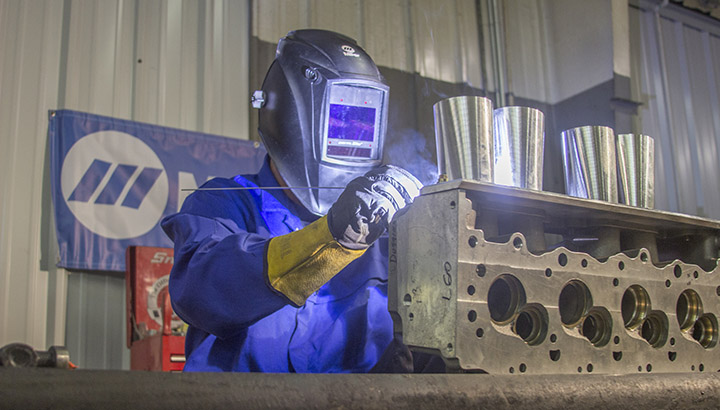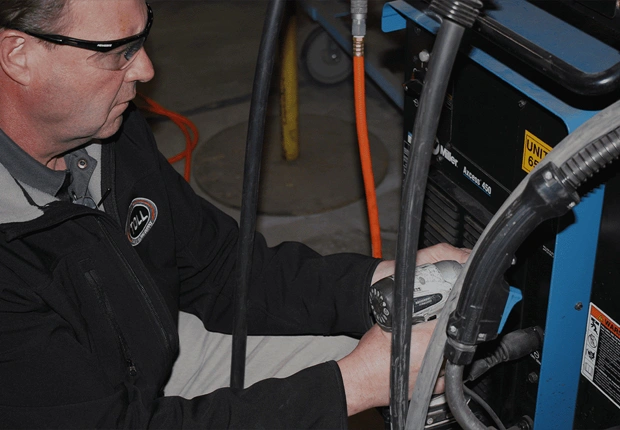What you should do when encountering porosity in Montana Mobile Welding and Repair Welding
Everything about Welding: Trick Insights Into Techniques and Ideal Practices for Success
Welding encompasses a variety of strategies, each matched for specific materials and applications. Recognizing these methods, such as GMAW, SMAW, and TIG, is important for achieving suitable results. Furthermore, the best tools and safety techniques can not be neglected. As prep work and fixing play important duties in the welding procedure, grasping these elements can significantly improve the top quality of the final item. What are the key factors that assure a successful weld?
Recognizing Various Welding Techniques
Welding methods include a variety of techniques, each fit to details applications and products. Amongst one of the most usual methods are Gas Metal Arc Welding (GMAW), Protected Steel Arc Welding (SMAW), and Tungsten Inert Gas Welding (TIG) GMAW, additionally known as MIG welding, is preferred for its rate and flexibility, making it ideal for slim products. SMAW, or stick welding, is preferred for its simpleness and efficiency in outside atmospheres, particularly with thicker metals. TIG welding supplies accuracy and control, making it ideal for elaborate work and non-ferrous metals (Belgrade). Each strategy has its distinct benefits and factors to consider, allowing welders to select the very best method based on the project's demands, material kind, and desired results. Comprehending these techniques is essential for effective welding
Vital Welding Devices and Devices
While different welding techniques call for certain abilities, the appropriate tools and devices are equally important for accomplishing top quality outcomes. Crucial welding tools consists of welding machines, which differ depending upon the method-- such as MIG, TIG, or stick welding. Protective gear, consisting of aprons, headgears, and handwear covers, warranties safety and security and comfort during the process. Furthermore, clamps and components aid protect materials in position, ensuring precision in welds. Consumables like welding rods, cord, and shielding gas are additionally important elements that influence the high quality of the weld. Devices such as cutters and grinders assist in surface preparation and post-weld finishing, contributing to a professional outcome. Spending in top notch equipment ultimately improves the efficiency and effectiveness of welding projects.
Safety Practices in Welding
Proper safety techniques are important in the welding market to secure employees from potential hazards. Welders must use ideal individual safety tools (PPE), consisting of helmets with appropriate shading, gloves, and flame-resistant garments. Adequate ventilation is vital to minimize direct exposure to hazardous fumes and gases produced throughout the welding procedure. Additionally, employees ought to be trained in the right handling of welding tools to stop mishaps. Fire precaution, such as keeping combustible materials away from the welding location and having fire extinguishers conveniently available, are required. Regular evaluations of tools and workspaces can assist recognize prospective threats before they cause mishaps. By sticking to these safety methods, welders can produce a safer working environment and lessen threats related to their profession.
Preparing Products for Welding
Preparing products for welding is a crucial step that substantially influences the high quality and honesty of the end product (Montana Mobile Welding and Repair Belgrade). Proper prep work includes cleaning the surface areas to eliminate pollutants such as corrosion, dirt, and oil, which can jeopardize the weld. Strategies such as grinding, fining sand, or using solvents are commonly utilized to achieve a clean surface. In addition, making sure that the products mesh snugly is necessary; spaces can cause weak welds. It's likewise vital to think about the placement and positioning of the parts, as this will certainly impact the simplicity of welding and the final result. Selecting the appropriate filler material and guaranteeing compatibility with the base steels is essential for accomplishing solid, resilient welds.
Tips for Achieving High-Quality Welds
Accomplishing premium welds requires interest to information and adherence to ideal techniques throughout the welding procedure. Appropriate joint preparation is crucial, guaranteeing surfaces are tidy and complimentary from pollutants. Selecting the proper filler product and welding technique based upon the base steels is essential for perfect bonding. Preserving constant travel rate and angle while welding can protect against defects and promote uniformity. Additionally, controlling warm input is vital; too much warmth can lead to bending and deteriorated joints. Regularly evaluating the welds during the procedure enables for immediate modifications if required. Ultimately, using ideal post-weld treatments, such as cleansing and stress relief, can improve the toughness and honesty of the weld, ultimately ensuring a successful result.
Troubleshooting Typical Welding Issues
Welding often provides obstacles that can influence the quality and integrity of the final product. Usual problems such as porosity, irregular weld beads, and overheating can emerge, each requiring details fixing techniques. Comprehending these problems is necessary for welders to boost their skills and achieve excellent outcomes.
Porosity Issues Explained
Although porosity can often be forgotten, it remains a critical problem in welding that can endanger the stability of an ended up product. Porosity refers to the existence of small gas pockets within the weld grain, which can lead and deteriorate the joint to premature failure. This issue commonly occurs from impurities, wetness, or More hints inappropriate shielding gas insurance coverage throughout the welding process. To reduce porosity, welders must validate that the base products are clean and completely dry, utilize ideal shielding gases, and keep consistent welding criteria. Regularly checking the equipment and environment can also aid determine possible concerns before they manifest in the weld. Addressing porosity successfully is important for attaining solid, long lasting welds that fulfill high quality criteria.

Inconsistent Weld Beans
Inconsistent weld grains can significantly affect the quality and strength of a completed product. Various factors add to this issue, including improper traveling speed, inaccurate amperage setups, and irregular electrode angles. When the welder moves too swiftly, a bead may appear slim and do not have penetration, while moving too slowly can trigger extreme accumulation. Furthermore, making use of the incorrect amperage can result in either damaging or excessive spatter, both of which compromise weld honesty. The welder's strategy, such as inconsistent lantern movement, can also cause uneven grain look. To reduce these issues, welders ought to concentrate on preserving steady, regulated motions and making certain proper equipment setups to achieve uniformity in their welds. Consistency is key to accomplishing trustworthy and solid welds.
Getting Too Hot and Bending Issues
Too much warm throughout the welding process can result in considerable overheating and warping concerns, impacting the structural stability of the workpiece. These issues often materialize as distortion, which can endanger placement and fit-up, making additional setting up challenging. Factors contributing to overheating include the option of welding criteria, such as voltage and travel rate, as well as the sort of material being welded. To mitigate these issues, welders need to preserve consistent traveling speed and suitable warm input while checking the workpiece temperature level. Furthermore, preheating or post-weld warm treatment can aid minimize stress and anxieties caused by quick air conditioning - Montana Mobile Welding and Repair Belgrade. Routine evaluation and adherence to best methods are important in protecting against overheating and making sure the long life and integrity of bonded structures
Regularly Asked Inquiries
What Are the Profession Opportunities in the Welding Market?
The welding market provides varied career possibilities, consisting of settings as welders, assessors, teachers, and engineers. Experts can function in manufacturing, building, aerospace, and automotive industries, gaining from solid need and affordable salaries in different functions.
Exactly How Can I Boost My Welding Speed Without Compromising Top Quality?
To enhance welding speed without you can look here sacrificing quality, one must practice reliable techniques, maintain tools, optimize settings, and enhance hand-eye sychronisation. Routine training and seeking comments can likewise considerably contribute to achieving quicker, high-grade welds.
What Accreditations Are Readily Available for Welders?
Many certifications exist for welders, consisting of those from the American Welding Society (AWS), the National Center this hyperlink for Building Education And Learning and Study (NCCER), and various industry-specific companies. These qualifications improve employability and demonstrate skill proficiency.
How Does Welding Affect the Properties of Metals?
Welding affects the homes of metals by modifying their microstructure, which can cause changes in strength, ductility, and hardness. Heat input and cooling prices throughout the procedure greatly affect these material attributes.
Can I Weld Dissimilar Metals With Each Other?
